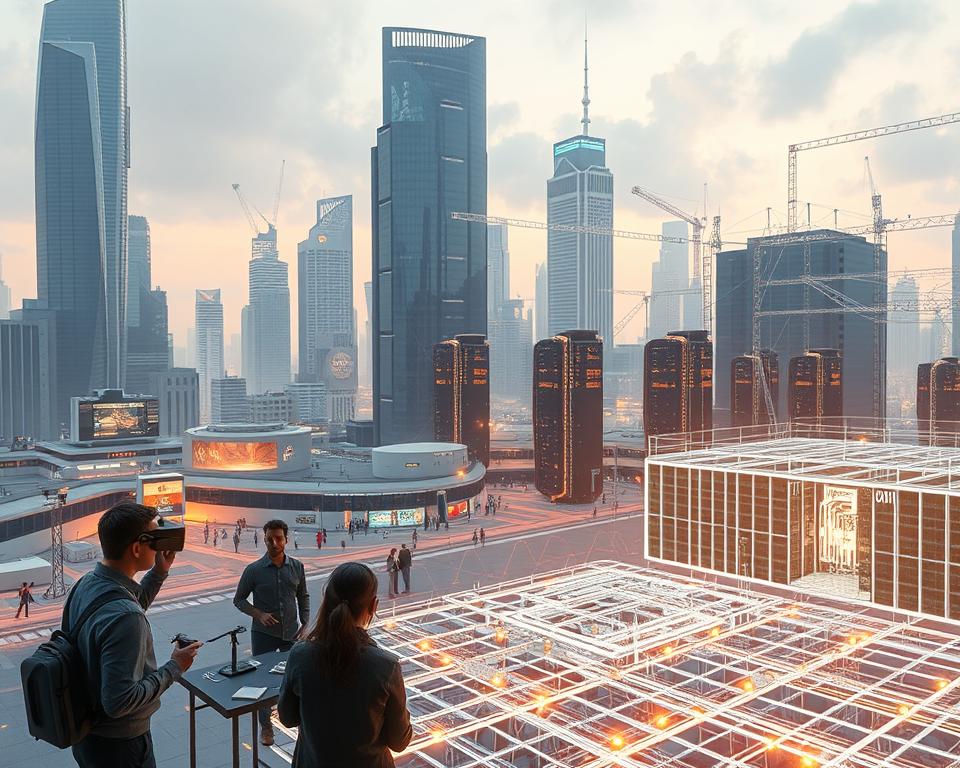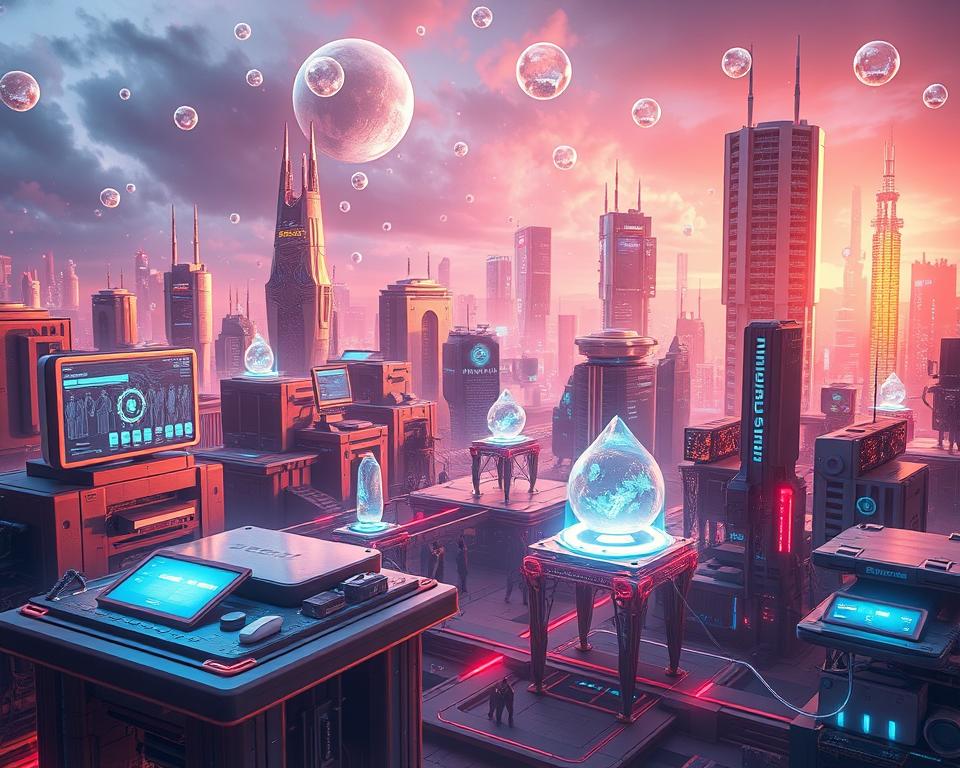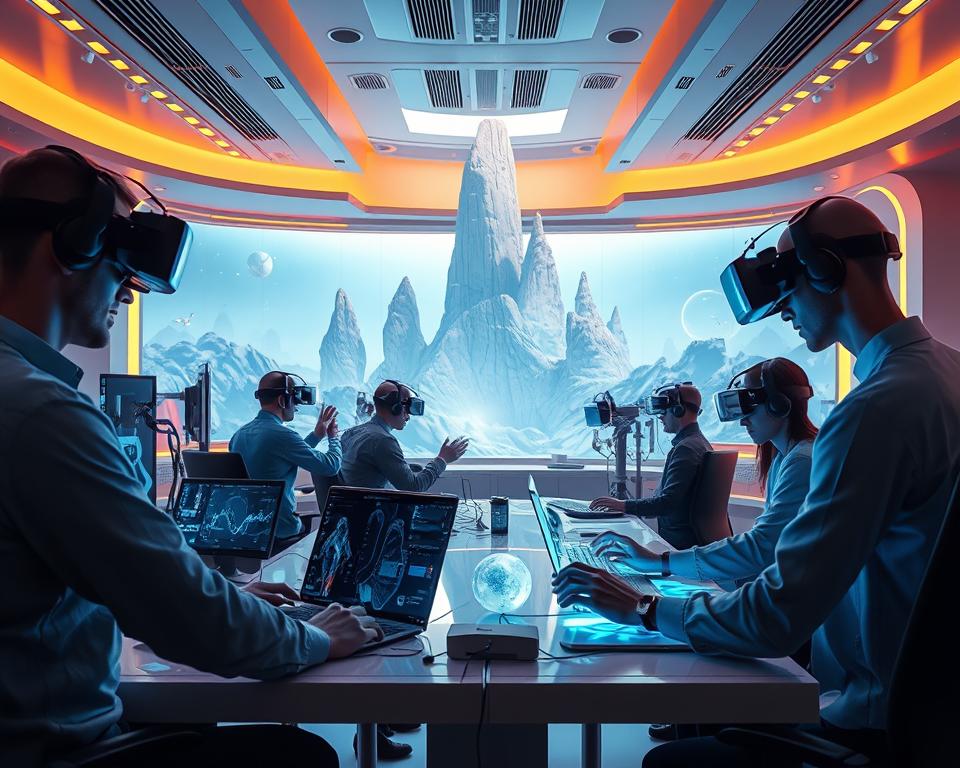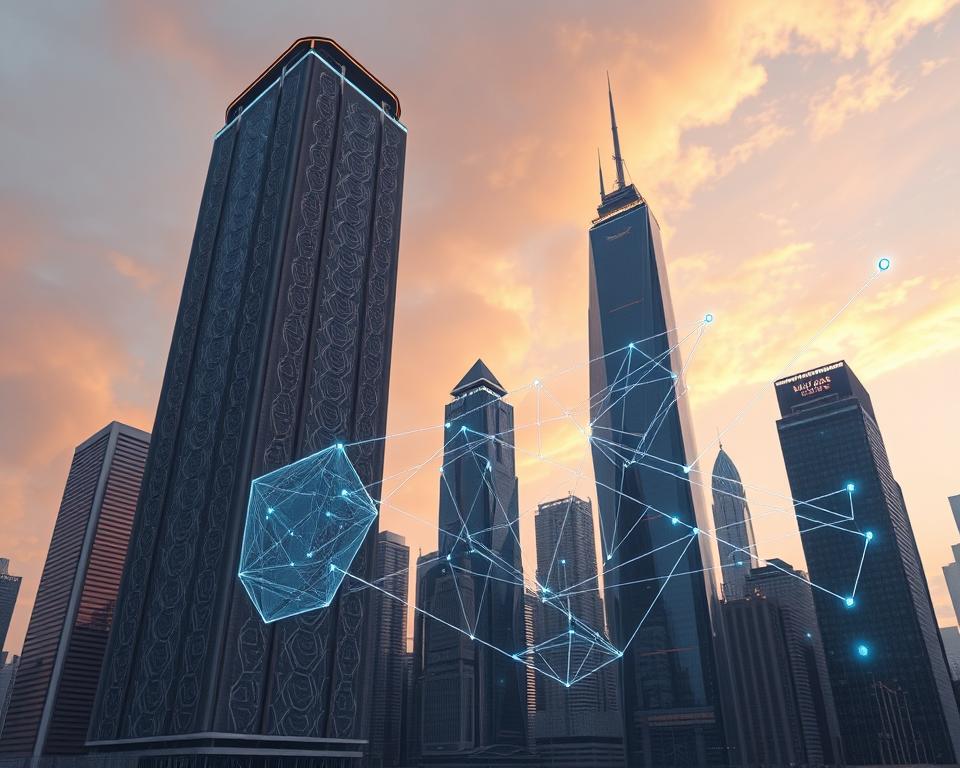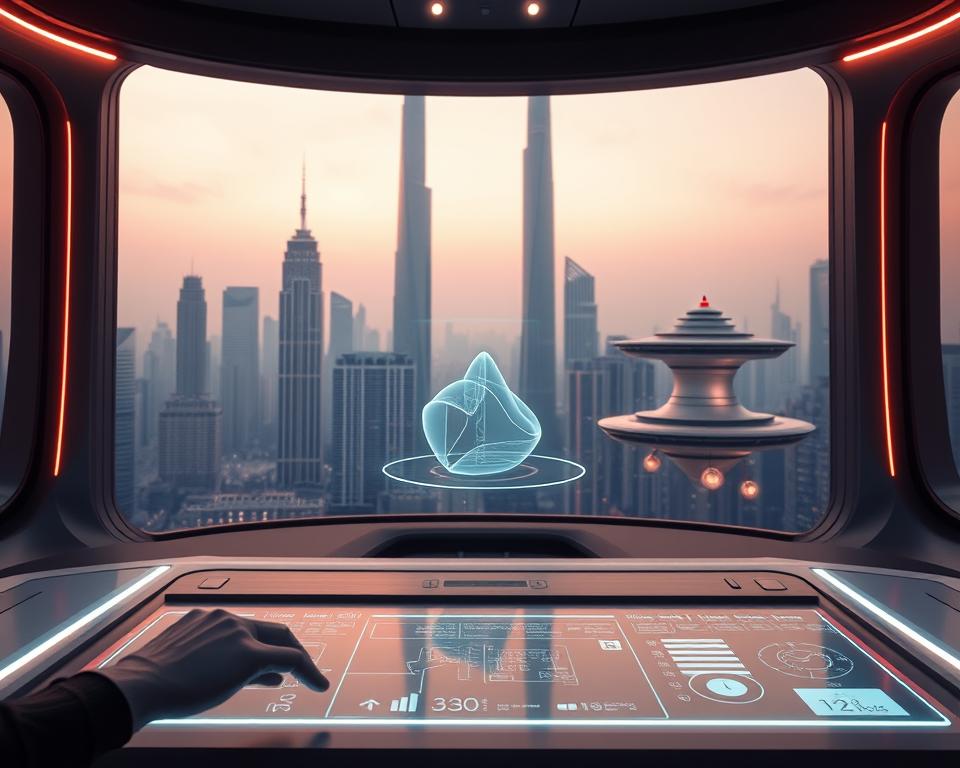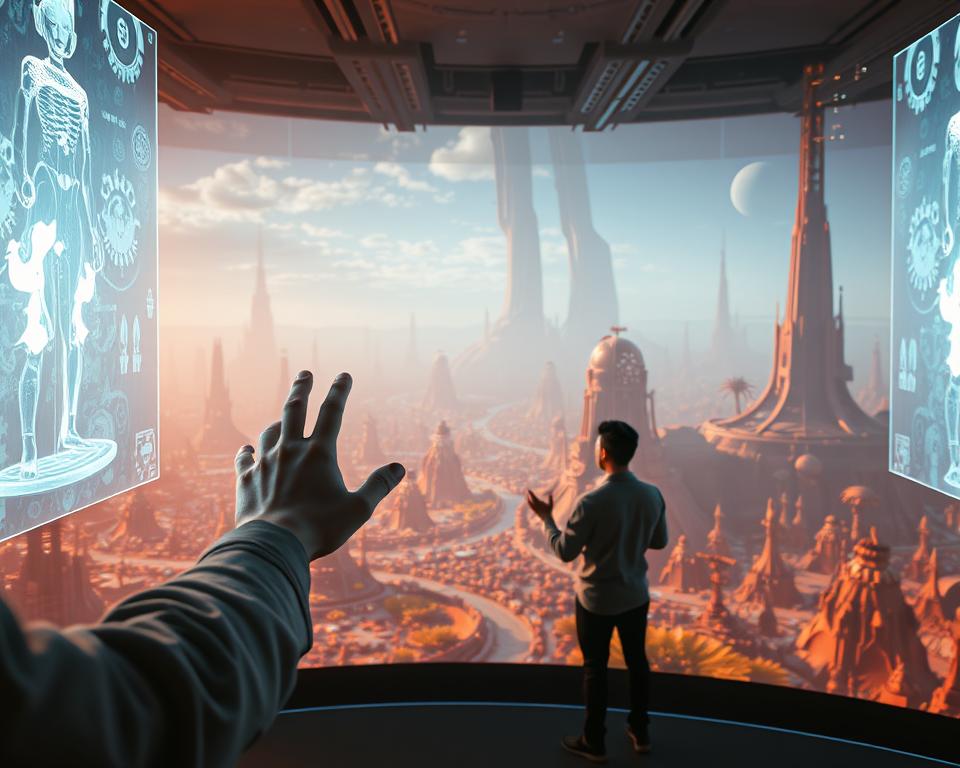The metaverse is a virtual world that blends augmented reality and virtual reality. It offers immersive experiences. Many companies are investing in this tech to create new experiences. It’s key to know the metaverse’s current state and its uses in development.
Virtual and augmented reality are vital in the metaverse. Knowing how to use these technologies is crucial. This guide will share tips and best practices for developing the metaverse. We’ll cover virtual reality, augmented reality, and the metaverse’s current state.
Table of Contents
Introduction to Metaverse Development
This guide aims to give a full view of metaverse development. It includes the tech’s current state and its uses. By learning the basics, companies and individuals can make innovative, immersive experiences. These experiences will use virtual and augmented reality.
Key Takeaways
- Metaverse development combines virtual reality and augmented reality to create immersive experiences
- Understanding the current state of metaverse technology is essential for successful metaverse development
- Virtual reality and augmented reality are key components of the metaverse
- Metaverse development has a wide range of potential applications
- Effective utilization of virtual reality and augmented reality is crucial for successful metaverse development
- Metaverse development is a rapidly growing field with many investment opportunities
Understanding the Metaverse Ecosystem
The metaverse ecosystem is a complex network of virtual worlds, augmented reality, and blockchain technology. It’s a shared, immersive space where users can create their own avatars and environments. They can also interact with others in real time.
This ecosystem is built on blockchain technology. It ensures secure and transparent transactions and data management.
Key technologies drive the metaverse ecosystem. Smart contracts enable self-executing contracts with terms written in code. Virtual reality (VR) and augmented reality (AR) provide immersive experiences for users.
- Virtual reality (VR) and augmented reality (AR) platforms
- Blockchain technology and smart contracts
- Artificial intelligence (AI) and machine learning (ML) algorithms
- Internet of Things (IoT) devices and sensors
These components create a seamless and immersive experience. They enable the creation of new applications and services in the metaverse ecosystem.
The metaverse ecosystem has the potential to transform many industries. This includes entertainment, education, healthcare, and finance. As it evolves, we’ll see new uses of blockchain technology and smart contracts. New business models and revenue streams will also emerge.
Essential Prerequisites for Metaverse Development
Metaverse development requires careful planning. A key part is understanding user experience. This means making a virtual world that feels real and engaging.
A good user experience is vital. It can make a project succeed or fail. Developers need to focus on user interface, navigation, and interaction design. This way, they can make a metaverse that’s easy and fun to use.
- Programming languages like C++, Java, and Python
- Software development kits (SDKs) such as Unity and Unreal Engine
- Knowing computer graphics, physics, and math
- Experience with cloud computing and distributed systems
By focusing on these areas and user experience, developers can make a metaverse that works well and is fun.
The secret to a great metaverse is balancing tech skills with user experience. When done right, developers can create a world that’s both real and interactive. This gives users a unique and exciting experience.
Choosing Your Development Platform
Choosing the right platform for metaverse development is key to success. There are many metaverse development platforms out there. It’s important to look at their features, strengths, and weaknesses to make a good choice. Performance optimization is also crucial because it affects how well the app works and how users feel.
Popular frameworks for metaverse development include Unity, Unreal Engine, and A-Frame. Unity is known for its cross-platform compatibility. Unreal Engine is famous for its high-performance graphics capabilities. When picking a platform, think about how long it takes to develop, the cost, and how well it can grow with your project.
To make sure your app runs smoothly, look at its technical needs. This includes what hardware and software it needs, and the network setup. By checking these things, you can pick a platform that fits your needs and gives users a great experience.
- Evaluate platform features and strengths
- Consider performance optimization and technical requirements
- Compare development time, cost, and scalability
Building Blocks of Virtual World Creation
Creating a virtual world is a complex task. It involves 3D modeling, texture mapping, and lighting. These elements combine to make a world that feels real and engaging. To learn more, visit virtual world creation guides.
Some key parts of virtual world creation are:
- 3D modeling: This is about making three-dimensional models of objects and characters for the virtual world.
- Texture mapping: It adds surface details to 3D models to make them look more realistic.
- Lighting: This creates a lighting system that mimics real-world lighting, including daylight and shadows.
By using these elements, developers can make a virtual world that looks amazing and is fun to explore.
To create a great virtual world, you need to know a lot about 3D modeling and other related skills. With these skills, developers can make worlds that feel real and interactive. These worlds can take users to new and exciting places.
Implementing Advanced Graphics and 3D Modeling
To make the metaverse feel real, developers need to work on graphics and 3D modeling. They must create detailed, high-quality assets. This makes the virtual world look better. Using performance optimization techniques, they can make complex graphics and 3D models run smoothly.
Creating and managing assets well is key. This means designing and optimizing 3D models, textures, and more. This way, they can make the visuals stunning. It keeps users engaged and immersed in the experience.
Some important things to think about when working on graphics and 3D modeling include:
- Optimizing 3D models for real-time rendering
- Using performance optimization techniques to reduce latency
- Implementing 3D modeling tools to create complex, detailed assets
By focusing on these areas, developers can make the metaverse look amazing. With advanced graphics and 3D modeling, they can create virtual worlds that are truly immersive.
Mastering Metaverse Development Tools
Metaverse development tools are key for making virtual worlds come alive. User interface design is vital for a smooth user experience. Developers need to learn about software development kits (SDKs), game engines, and 3D modeling tools.
Unity and Unreal Engine are top choices for these tools. They offer many features to help developers build detailed virtual worlds. With these tools, developers can make metaverse experiences that look great and are fun to use.
- Learn the basics of 3D modeling and game development
- Familiarize yourself with metaverse development tools and platforms
- Join online communities and forums to connect with other developers and learn from their experiences
By following these steps and mastering metaverse development tools, developers can create amazing metaverse experiences. Good user interface design is essential. It makes sure users can easily interact with the virtual world.
Integration of Blockchain and Smart Contracts
Blockchain and smart contracts are key in metaverse development. They make transactions safe and clear. This tech changes how we deal with virtual worlds, making transactions secure and quick.
Using blockchain and smart contracts in metaverse development brings many benefits. Here are a few:
- Enhanced security through the use of blockchain technology
- Increased transparency and accountability through the use of smart contracts
- Improved efficiency and speed of transactions
When it comes to security, blockchain and smart contracts are top-notch. They protect against fraud and other bad activities. This means users’ digital assets are safe and sound.
User Interface Design for Virtual Environments
When making virtual environments, user interface design is key. It makes the experience immersive and fun. A good interface can greatly improve how users enjoy and use the virtual space.
Designing a good interface involves thinking about feedback, navigation, and how things are shown. Feedback tells users their actions are recognized. Navigation should be simple and clear. And, how things are shown is crucial for understanding and interacting with the virtual world.
Here are some tips for designing a great user interface for virtual environments:
- Keep it simple and intuitive
- Use clear and concise language
- Provide feedback and navigation cues
- Use visualization to enhance the user experience
By using these tips and thinking about what virtual environments need, developers can make interfaces that work well and are fun. This leads to a smooth and enjoyable experience for everyone.
Creating Immersive User Experiences
Immersive user experiences are key in the metaverse. They let users dive into virtual worlds in a real and fun way. To make this happen, developers need to focus on social interaction features. These include chat, virtual events, and games.
For more on designing these interactions, check out virtual reality apps design tips.
Designing the environment is also vital. Developers must think about lighting, texture, and sound. This makes the virtual world feel real and fun. Plus, avatar systems development is key. It lets users show who they are in the virtual world.
Some important things for immersive experiences are:
- Realistic graphics and sound effects
- Intuitive user interfaces
- Engaging social interaction features
- Customizable avatar systems
Social Interaction Features
Social features are crucial for immersive experiences. They help users connect and feel part of a community.
Environmental Design Principles
Designing the environment is essential. Developers must think about lighting, texture, and sound. This makes the virtual world feel real and engaging.
Avatar Systems Development
Avatar systems are vital for self-expression. They let users customize their virtual look with clothes, accessories, and animations.
Performance Optimization Strategies
In metaverse development, performance optimization is key for a smooth user experience. Developers should work on improving graphics, physics, and scripting. This means using methods like optimizing code and cutting down on extra work.
Some important ways to boost performance in metaverse development include:
- Using level of detail techniques to cut down polygon counts
- Implementing occlusion culling to lessen unnecessary rendering
- Optimizing physics simulations to lower computational load
By using these methods, developers can make their metaverse apps run better. This leads to a better experience for users. As the metaverse grows, making it run smoothly will become even more vital. It will help developers build more detailed and engaging virtual worlds.
Optimizing performance is not a one-time task, but rather an ongoing process that requires continuous monitoring and improvement.
By focusing on performance, developers can make sure their apps handle lots of users well. This is crucial for metaverse success. Slow or unresponsive apps will make users unhappy.
Security Considerations in Virtual Worlds
As virtual worlds grow, security is now a major focus. More personal data is shared and stored here. It’s crucial to have strong data protection to stop unauthorized access and misuse. Protecting user privacy is also key, through clear data collection and storage.
To keep virtual worlds safe, developers can take several steps. These include:
- Encrypting user data
- Using secure login and access controls
- Doing regular security checks and updates
It’s also vital to teach users about security best practices. This helps protect their personal data in virtual worlds. By working together, developers and users can make a safe space for everyone. This improves the experience and builds trust, helping the virtual world succeed and stay secure.
Monetization Strategies for Metaverse Projects
Developers of metaverse projects are always searching for ways to make money. The type of project matters a lot. For example, a gaming metaverse might use in-game buys or subscriptions. On the other hand, a social metaverse could rely on ads or sponsored content.
Choosing the right way to make money is key. A strategy that bothers users too much can hurt the project’s image and earnings. Metaverse projects often mix different ways to make money. Some common methods include:
- Subscription-based models, which give users special content or features
- Advertising, which can bring in money from targeted ads
- Sponsored content, which lets brands create fun and interactive experiences for users
By picking the right monetization strategies and keeping users happy, developers can make their projects successful.
It’s important to remember that the best way to make money changes with each project. Trying out different strategies and listening to what users say helps developers find what works best. This way, they can make their metaverse projects thrive.
Testing and Quality Assurance
Creating a smooth user experience is key in the metaverse. That’s why quality assurance is so important. It involves user testing to find and fix problems that might ruin the experience. By adding testing to the development process, developers can make sure their product is top-notch and meets user needs.
Quality assurance covers several important areas:
- Performance benchmarking to ensure the metaverse platform can handle a large number of users
- Identifying and resolving bugs through thorough testing and debugging
- Conducting user testing to gather feedback and make necessary improvements
By focusing on quality assurance, developers can make a metaverse that’s fun and dependable. This leads to happier users who stick around. As the metaverse grows, so will the need for testing and quality assurance.
Scaling Your Metaverse Platform
As a metaverse platform grows, it’s key to think about the infrastructure it needs. Scaling a metaverse platform means planning carefully to keep the user experience smooth. Load balancing is a crucial step, spreading the workload across servers to avoid crashes.
Experts say a good infrastructure is essential for handling more users and traffic.
Scaling up requires the right infrastructure requirements. This means investing in fast servers, storage, and network gear. Also, using load balancing techniques helps spread the workload evenly. This ensures users have a smooth experience, even when lots of people are online.
To scale well, metaverse platforms should follow these tips:
- Keep an eye on user activity and traffic to know when to scale up
- Use automated scaling to quickly adjust to demand changes
- Consider cloud services for easy scaling up or down
By focusing on scaling and infrastructure, metaverse platforms can offer a top-notch experience. As the metaverse grows, it’s vital for platforms to plan for the future. They must ensure their infrastructure can handle more users and traffic.
Future-Proofing Your Development
As metaverse development grows, it’s key to think about future-proofing your project. This means keeping up with new tech and trends. Doing this helps your metaverse stay current and competitive over time.
Here are some important steps for future-proofing your metaverse project:
- Stay updated on new technologies and trends.
- Create a flexible and adaptable development framework.
- Encourage your team to keep learning and improving their skills.
By focusing on future-proofing, you can avoid your project becoming outdated. This helps you stay ahead and achieve lasting success in metaverse development.
Conclusion: Launching Your Metaverse Project
Launching your metaverse project is just the start of an exciting journey. The metaverse world is always changing. It’s key to keep up with new trends and tech to succeed.
By following this guide, you’ll be ready to handle the challenges of metaverse development. You’ll create a vibrant virtual world.
When you launch, remember to always learn and get better. Keep up with new metaverse tech and listen to user feedback. This will help you grow a loyal community and keep your project thriving.
With good planning and constant improvement, you can make a metaverse project that draws people in. Whether you’re experienced or new, success comes from being adaptable and innovative. So, start building your metaverse project today. Get ready to launch a new era of immersive experiences.









